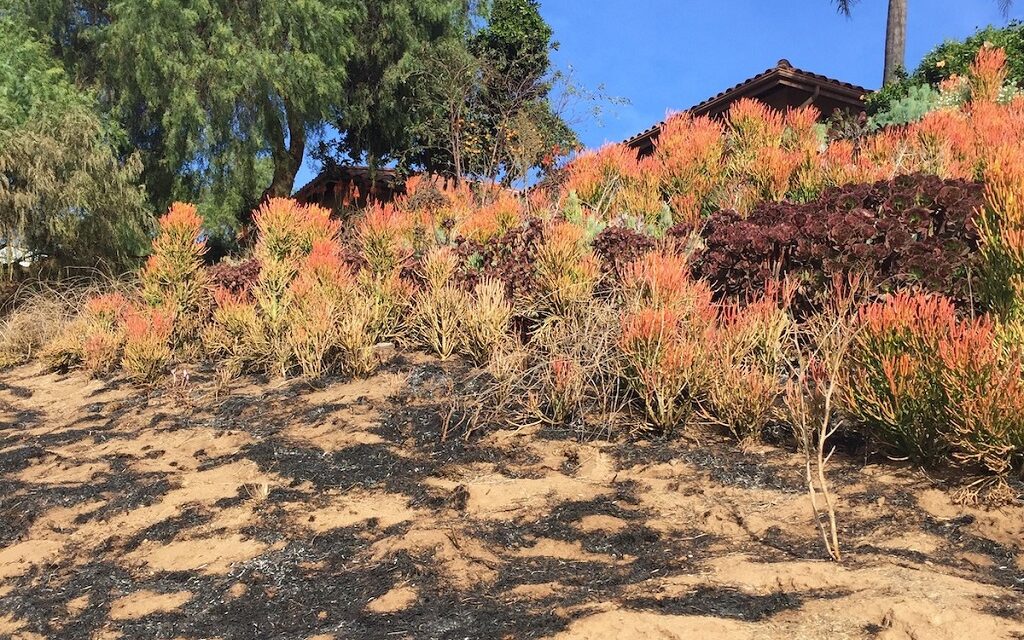The main image is courtesy of Debra Lee Baldwin, which features the aftermath of a succulent filled hillside that served as a firebreak during the 2017 Lilac Fire in San Diego County.
As September begins, we can’t escape the promise of heatwaves and the last vestiges of summer as temperatures swell for one last hot-spell before the cool breezes of autumn take over. Living in Southern California we are always additionally concerned about wildfire season this time of year, and choose to remain close to home, just in case.
One thing is certain, the Los Angeles County Fire Department has perhaps the best trained, most innovative firefighters in the world, as they get plenty of practice from seasonal wildfires that are always imminent, regardless of the amount of rainfall during the year.
One topic that has become especially interesting to our neighbors and other homeowners throughout the west is “Firescaping“, which is a combination of both landscaping and hardscaping, while using native plants to create defensible space around your home.
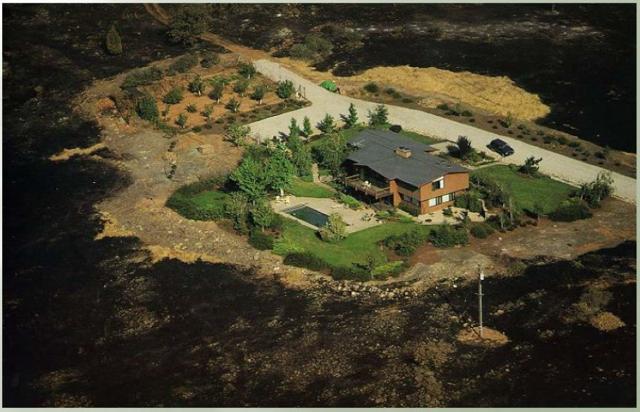
Photo courtesy of the Santa Barbara Fire Department & Santa Maria Times
Even if you do not live in an area prone to wildfires, the principles of firescaping are applicable to protecting your home from the threat of a neighboring fire spreading to your property. All homeowners should keep their neighbors’ properties in mind when planning for fire safety, as a raging fire next door can quickly spread to your property without adequate defensive space in place. Additionally, the principles of firescaping should be applied to fire pits and barbecue grills.
Covered in this article are the basics of firescaping, how it can add layers of protection around the exterior of your home, and the many choices of attractive fire resistant plants, shrubs and trees.
Table of Contents
- Do Fire Resistant Landscapes Work?
- Which Plants are Fire Resistant?
- How to Use Firescaping to Protect Your Home
- Firescaping Resources
Also see:
Do Fire Resistant Landscapes Work?
In December 2017, northern San Diego County, California witnessed one of the most devastating wildfires that eventually burned 4,100 acres. Known as the Lilac Fire, this conflagration was the second-costliest wildfire to hit Southern California that year, as it destroyed 157 structures before it was contained nine days later.
Photos of the destruction caused during the Lilac Fire revealed that some homes actually survived due to fire-resistant firescaping, which caused the fire to cease when they reached moisture-retaining plants, such as native succulents. This phenomenon was captured in a number of photos that affirm that succulents and certain other plants and shrubs are fire retardant, especially jade and cactus, and can form a natural fire barrier for your property.
It is important to understand that a rapid wildfire needs three things: heat, air, and fuel. Since there is nothing that homeowners can do about heat or air, they can, however, control the amount of available fuel on their property. By surrounding their homes with slow- or low-burn plants, shrubs and trees, homeowners can retard fire approaching their structures.
The idea behind firescaping is to combine drought tolerant, high moisture flora with masonry gravel, stone walls and patios to impede the advancement of flames. Strategic placement of plants and shrubs is also critical, such that there is sufficient spacing between both groups of vegetation and the structures of one’s home. Decorative paving stones, such as river rocks, stepping stone pathways and walkways, along with fire resistant vegetation, are all options for creating defensible spaces.
How to Use Succulents as a Firebreak
Also see:
Which Plants are Fire Resistant?
Professional landscape designers will tell you that the plants you choose are just as important as their placement in order to protect your home and other structures on your property. When homeowners hear the word “succulent” they typically think of cacti, and other spiny, thorny, “not very pretty” plants that will make their yard look like an Arizonan Desert.
However, succulents, such as cactus and aloe, are not the only fire resistant plants that you can or should employ in your arsenal. There are a number of beautiful, flowering trees, plants and shrubs that are classified as fire resistant that can help create a defensible space for your home, while creating curb appeal, shade and natural beauty.
Also see:
Flowing Plants
Drought tolerant flowering plants bursting with color and fragrance can enhance any property, be they in a planter, or along walkways, or bordering larger trees or shrubs.
Also see:
Lavender
The scent of calmness, lavender plants are true pollinators that attract bees, birds and butterflies, while extolling the benefit of requiring very little maintenance and enjoy dry soil conditions.

PlantingTree.com Sensational Lavender Plant Lavandula Intermedia ‘Sensational’
Daylily
Although not a true “lily” the perennial daylily has a similar shape to lilies and gets its name from the behavior of its flowers opening in early morning and withering in the evening.
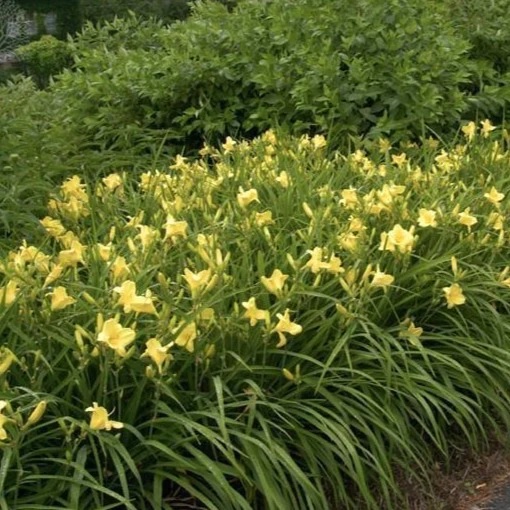
PlantingTree Happy Returns Daylily Hemerocallis
Salvia
Hummingbirds, butterflies and honeybees love Salvia’s fragrant, tubular flowers and homeowners love the color display they bring to any planter or border arrangement. The ease of maintenance and propagation along with their low watering needs means you can create fields of Salvia with one plant.

PlantingTree May Night Salviad Salvia x Sylvestris
Hen and Chicks
A clustered, rosette-type succulent, Hen and Chicks plants are so named because the “hen” or center of the plant, acts as the mother to the “chicks”, or its offspring, which cluster around her. As succulents, hen and chicks store water in their stems, and thus, are perfect barriers as hillside cover in fire prone areas.

PlantingTree Sempervivum Sunset Succulent “Hens and Chicks” Sempervivum Tectorum
Shrubs
Create a vibrant color pattern near a retaining wall or fence with hardy drought tolerant shrubs that can provide color and a measure of privacy.
Golden Currant
A shrub that can grow 12’ tall with yellow, pollinator-attracting flowers and a spicy fragrance that smells similar to vanilla or cloves.
Heather
A perennial shrub that grows up to 4 inches tall and blooms in early spring can provide excellent ground color for border areas as it has full season color with tiny evergreen fern sprays. This fully drought-tolerant shrub is low maintenance but has high appeal.
Russian Sage
A sun-loving perennial that has purple blooms for weeks on end that grows upright reaching up to 4 feet tall.
Trees
Fire resistant, flowering trees with wide canopies can provide shade to smaller plants and shrubs, while also protecting your home. Invite pollinators, such as birds, butterflies, and bees with drought tolerant trees that can grow up to 70 feet tall.
Also see:
Black Oak
A large, drought-tolerant tree makes a sturdy addition to any yard, as it attracts squirrels and birds for their abundant acorns.
Cherry
Many varieties of cherry trees are resistant to fire and therefore are a preferred choice for any landscaping project. They also attract pollinators during the spring flowering season, while producing fruit during the early summer.
Honey Locust
A strong, fast-growing shade tree that can be up to 70 feet tall is also known as the Thorny Locust due to the spikes along its branches. Since it tolerates a wide range of soils, including acidic, alkaline, moist, dry and salty soils, it is considered an aggressive, invasive tree that does well under adverse conditions.
How to Use Firescaping to Protect Your Home
Following the guidelines set forth by CAL FIRE (the California Department of Forestry and Fire Protection), the recommended approach to making your landscape fire resistant is to create a Defensible Space around your home that is segmented into three zones:
- Zone 0: The Ember-Resistant Zone (0 to 5 feet from home)
- Zone 1: The Lean, Clean and Green Zone (5 to 30 feet from home)
- Zone 2: The Reduced Fuel Zone (30 to 100 Feet from home)
- How to Assess Your Home Video from the NFPA (National Fire Protection Association)
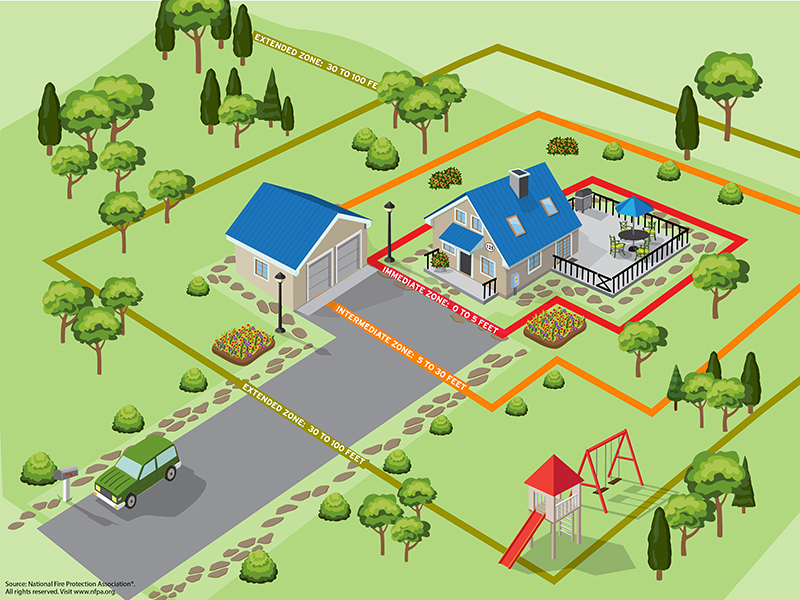
NFPA Defensible Space Zones Diagram
The purpose of using your surrounding landscape as a defensible space is to create a buffer between an on-coming fire and sources of nearby fuel (e.g. grass, trees, shrubs, neighboring structures, combustible items, etc.) located on the perimeter of your property.
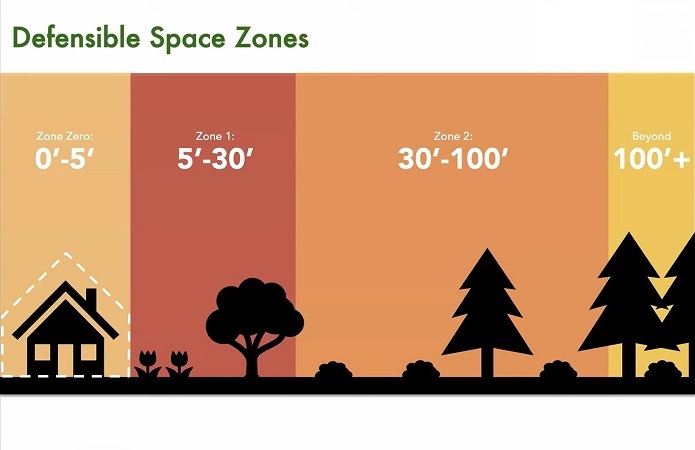
Fire Safe Marin Defensible Space Zones
This approach is relevant for curtailing fire damage for both rural homes encountering wildfires, as well as suburban homes situated nearby to a neighboring home that is on fire.
Firescaping is also referred to as Fire Resistant Landscaping, Fire Smart Landscaping , Firewise Landscaping, or Wildfire Defensible Space Landscaping. We prefer using the term Firescaping, as its definition includes “hardscaping”, as in:
- Firescaping = Landscaping + Hardscaping
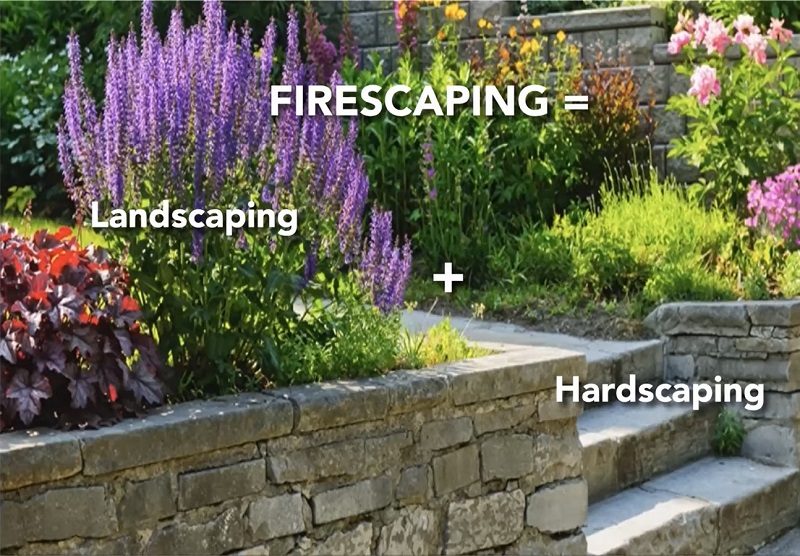
Image courtesy of Fire Safe Marin
Though more costly and time-intensive than ordinary landscaping, hardscaping can play a critical role in providing an additional structural protection around your home.
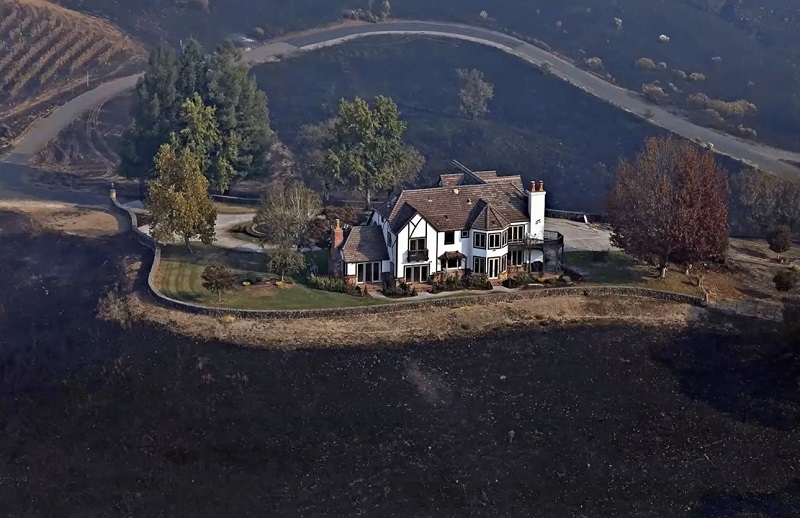
Fire Safe Marin Defensible Space Around Mansion Paradise Fire
Even if a well-designed “firescaped” property is unable to stop an approaching fire, the ability to slow a fire can be the difference between saving your home or not. The extra time can enable local firefighters to get into place in order to mitigate the situation fully.
Zone 0
The Ember-Resistant Zone (0 to 5 feet from home)
Zone 0 is also referred to as the Noncombustible Zone, the Immediate Zone, the Home Ignition Zone Zero, and the Zero Zone. Admittedly, it makes us think of the concept of “Ground Zero”, as in this is the area most important to protect. In general, you will want use as many ember-resistant materials in, on and around your home as possible. For landscaping in this zone think gravel, concrete or brick walkways, as well as other hardscaping features.
Hardening Your Home
When exploring how to improve your home’s protection from external sources of fire, especially for Zone 0, you need to keep in mind the three sources of exterior fire:
- Embers
- Direct Flame Contact
- Radiant Heat
For the best protection from external sources of fire, creating a Defensible Space should be done in combination with Hardening Your Home, as this will help protect your home against burning embers, the leading cause of home ignitions during wildfires.
Examples of simple approaches to hardening your home in Zone 0, include:
- Remove all plants, shrubs, branches and trees within five feet of any structure
- Replace combustible mulch with gravel or crushed stones
- Replace natural fiber doormats with heavy rubber or metal grates
- Clearing out overgrowth and combustible storage items underneath decks
- Remove flammable or combustible materials
- Remove anything that might easily burn, such as firewood or combustible outdoor furniture
- Remove dry leaves and debris from the roof and rain gutters

Image courtesy of Utah State University Forestry Extension Program Firewise Landscaping Preventing Fire Ladders
Examples of advanced approaches to hardening your home in Zone 0, include:
- Add fire-resistant ember defense solutions: gutters, vents, roofs, chimney crowns
- Add fire-resistant building components: windows, doors, siding
- Use fire-resistant building materials
- Active exterior roof sprinkler systems for home protection
Zone 1
The Lean, Clean and Green Zone (5 to 30 feet from home)
The goal of Zone 1 is to reduce the risk of fire spreading from surrounding plants and vegetation to the home.
- “Lean” implies that there should only be a small amount of vegetation, if any, and it should be grouped into discontinuous islands.
- “Clean” references a proactive approach to maintenance by consistently removing natural debris and dead materials.
- “Green” means that any vegetation located in Zone 1 needs to be kept green and well-irrigated, as much as possible, during the fire season.
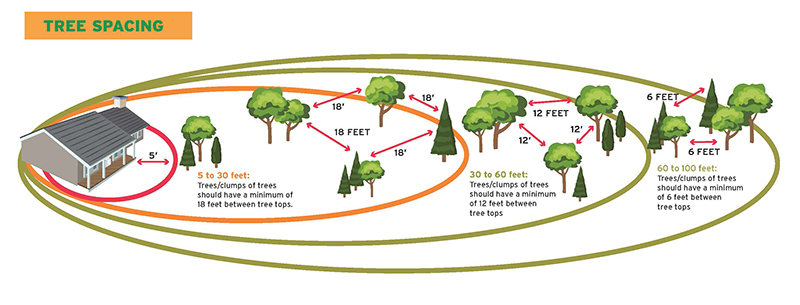
National Fire Protection Association (NFPA) Recommended Tree Spacing in Zones 1 and 2 for Firescaping
Also see:
Zone 2
The Reduced Fuel Zone (30 to 100 Feet from home)
The goal of Zone 2 is to reduce the spread of fire and its movement into the crowns of trees and shrubs. Key to maintaining this area is to keep large trees adequately spaced and to remove: dead vegetation; lower tree branches; and other lower-level fuels (e.g. smaller trees, shrubs, grasses, etc.).
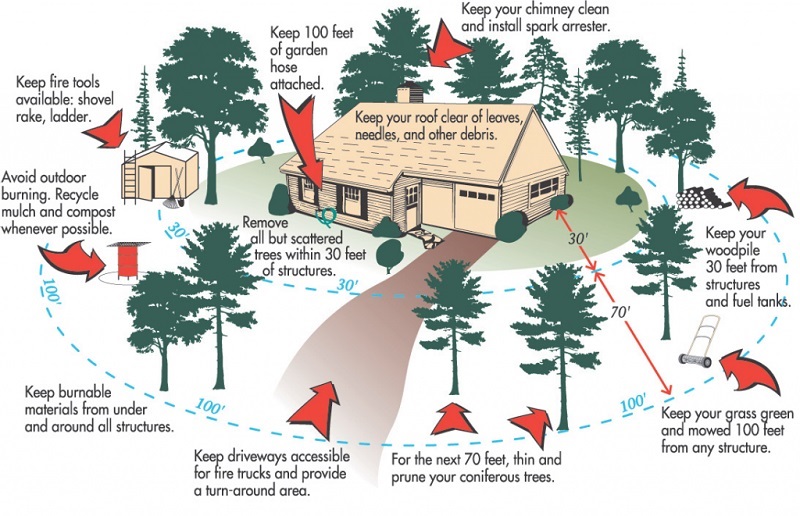
Mendocino County Fire Safe Council Recommended Landscaping by Zone
Also see:
How to Assess Your Home Video from the NFPA
Here is a highly informative video produced by wildfire expert Dr. Jack Cohen and the National Fire Protection Association that will give you reassurance that even the “little things” under your control to thwart the spread of fire can make a significant difference.
Your Home Can Survive a Wildfire
Firescaping Resources
- NFPA Home Ingnition Zone Checklist Infographic
- Wildfire Home Retrofit Guide (PDF)
- Live Fire Map from Frontline Wildfire Defense
- How to Create a Fire Smart Landscape
- Fire Safe Marin YouTube Channel
- Native Gardening 101: Firescaping (Video)
- 30 House Fire Statistics to Inform Your Household
- The Ultimate Home Emergency Preparedness Guide
- Wildfire Safety Guide
Firescaping Books
- Firescaping: Protecting Your Home with a Fire-Resistant Landscape
- Firescaping: Creating Fire-Resistant Landscapes, Gardens, and Properties in California’s Diverse Environment
- Fire Smart Home Handbook: Preparing for and Surviving the Threat of Wildfire
- The Drought-Defying California Garden: 230 Native Plants for a Lush, Low-Water Landscape
- Designing with Succulents
Ember Defense Products
Fire Resistant Materials
- Top 6 Fire-Resistant Building Materials
- 8 Fire Retardant Building Materials You Didn’t Know About
- Understanding the Fire-Resistance of Building Materials
- The Combustibility of Landscape Mulches
- Synlawn Class A Rated Fire Resistant Artificial Grass
Recommended Landscaping & Gardening & Articles
- The Traits & Risks of Dangerous Trees: Is Your Property Safe?
- Uber Apps for Lawn Care & Outdoor Services
- How to Create a Thriving Pollinator Garden with These Plants & Trees
- Best Fruit Trees to Plant by Hardiness Zone
- Pestie: The 411 on the Popular DIY Pest Control Subscription Service
- Current State of Landscaping Technology for Your Home
- 7 Ingenious Tech Products for Weed and Pest Control
- 9 Helpful Gardening Apps to Augment Your Green Thumb
- Best Garden & Landscaping Shows Now on Amazon Prime
- Improve the Health of Your Garden & Lawn with Professional Pet Waste Removal Services
| Purgula is reader-supported. When you click on links to other sites from our website, we may earn affiliate commissions, at no cost to you. If you find our content to be helpful, this is an easy way for you to support our mission. Thanks! Learn more. |

